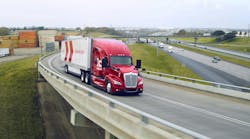Ever put your pedal to the metal, only to see a sudden drop in the speed limit? That may be what is happening to trucking and the economy today.
There are several signs that trucking has hit the accelerator. Sales of Class 8 vehicles have been so strong that some manufacturers reportedly had sold out their full calendar 2004 production by June. Shippers in Texas, Florida, the Midwest and the Northeast have been complaining for months that they aren't getting all the trucks they request or at least can't get them on short notice. In some cases, fleets are finally succeeding in getting shippers to pay fuel surcharges and penalties for holding up drivers at the loading dock.
Another sign of life, although a mixed one, is in the monthly payroll employment count from the Bureau of Labor Statistics. The trucking industry as a whole shed 86,000 employees, or 6% of payroll employment, from April 2000 to April 2003. Since then, the industry has hired 36,000 employees. That 3% pickup is more than double the rate of employment gains in the economy overall.
Most of the employment pickup has been in long-distance less-than-truckload and local specialized trucking. There has been no gain in payroll employment in long-haul truckload, although self-employment may have risen.
The demand for trucks and drivers results from three factors: a broad-based economic expansion, continuous shrinking of inventories relative to sales at all levels of production, and adjustment to the new hours-of-service rules. What is likely to happen to these trends in the near future, and what will the net effect on trucking be?
The most important influence, and the one with the greatest volatility, is economic growth. Recently, the Bureau of Economic Analysis lowered its estimate of first-quarter growth for inflation-adjusted gross domestic product (real GDP) from 4.4% to 3.9% at a seasonally adjusted annual rate.
Several indicators suggest the second quarter also was softer than initially expected. Seasonally adjusted payroll employment rose less than half as fast in June as in May or April, and the gains for those months were adjusted downward a tad. Surveys of purchasing executives in 20 manufacturing industries and 17 non-manufacturing sectors conducted monthly by the Institute for Supply Management showed expansion in June, but at a slower rate than in previous months. Manufacturers' orders fell in May, although shipments rose. In short, growth is continuing but apparently no longer accelerating.
The decline in inventories, relative to retail and wholesale sales and to manufacturers' shipments, has been good news for trucking, at least when sales and shipments rise, because it means businesses are relying more on truck deliveries rather than stockpiles. But the I/S ratio, as it is called, may start to rise soon, either because sales cool faster than producers and retailers anticipate, or because shortages and delivery bottlenecks lead to more stocking. A flattening or rise in the I/S ratio probably will mean slower growth or falling demand for trucking services.
The bottom line: Nobody believes the economy has run out of gas. But the acceleration that took real GDP from reverse in late 2001 to the fastest half-year growth in 20 years in late 2003 appears to be over. And the special factors that added still more to trucking demand are not likely to contribute further. Therefore, now is the time to review your truck orders and hiring plans to make sure you aren't fined for speeding in a slow-growth zone ahead.


